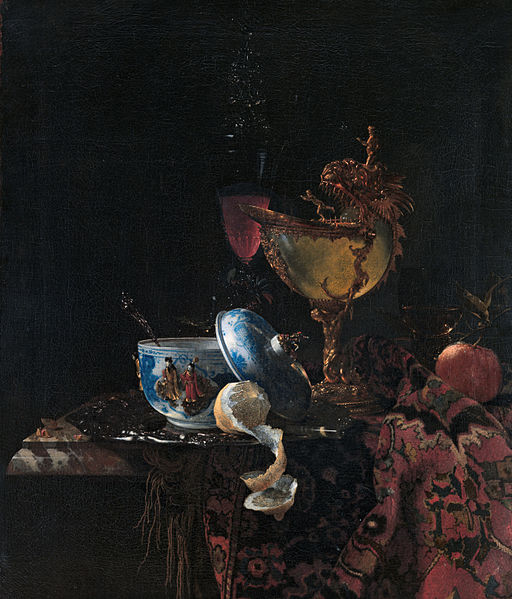Most holiday bread recipes include candied orange (and lemon) peel so today's entry is dedicated to this lovely sweet treat.
The idea of candying fruit dates back to the 14th century when sugar in Europe was
basically a luxury. At the same time, oranges & lemons were categorized as tropical fruits and this categorization was not to be abandoned for the next four hundred years. Willem Kalf (1619-1693), a Dutch painter often remembered as 'the Vermeer of still life', was nearly obssessed with them. He was born into a rich family of Rotterdam, studied in Paris, worked in Italy, and finally returned to Holland. Some time after marrying a cultivated woman, he moved to Amsterdam, where he not only painted also dealt in works of art. His still lifes were greatly admired for the precision of the details. I would also note that, even though his colleagues favored apples, peaches, and grapes (lots and lots of grapes), one piece of fruit, and certainly no more than four or five, were enough for Rembrandt's follower to create a powerful image. The photogenic yellow, of lemon skins especially, fascinated Kalf as much as the light on the surface of the plates, jugs & bottles that gleam on his masterly arranged still lifes as the pearl earring gleams in Vermeer's famous work. Another contrast that he put into effect was between the yellow of the lemon and the red of his expensive Persian carpet. Similarly to other Dutch examples of the genre in those days, Kalf's compositions underlined the transience of life although 'vanitas' usually involved the painting of skulls. All the more since he deliberately chose objects from gold, crystal, porcelain, silk, and fine wool -precious materials imported from the East, where orange and lemon trees were also cultivated. Incidentally, and despite his personal wealth & status, 'the Vermeer of still life' also liked to paint the interior of kitchens.
 |
| Dessert by Willem Kalf, 1653-1654 |
 |
| Still Life with Jug and Fruit - Willem Kalf (1656) |
 |
| Still Life with a Nautilus Cup (Willem Kalf, 1662) |
 |
| Still Life with Lemon Peel - Willem Kalf, 1664 |
Having
conquered the hearts of western European artists with their beauty, 'tropical' fruits would also dominate the haute cuisine
even before the term was used in France. Candied orange and lemon peel was served at festive dinners, either between two courses (and then
you had 'entremets') or at the very end -in place of dessert. These and other sweetmeats were the highlight of medieval, Renaissance and Early Modern
banquets. According to The English huswife, published in 1623, confections should appear on the festive menu in a specific order: marzipan - comfits - pastries - sweetmeats - preserved fruit - candied fruit - marmalade. For all of these sweet treats, Gervase Markham offered recipes. Marzipan, tarts, cakes, gingerbread, preserved
quinces, and 'sucket' had each their own chapter in The English Hvswife, with detailed
instructions as to preparation. From the context, we understand that
sucket (obsolete term for 'sweetmeat') was just another word for
'candied fruit'. The recipe for making sucket, or candying, in Gervase Markham's words, is featured on page 124:


Comments